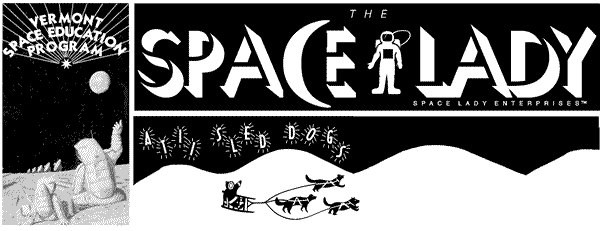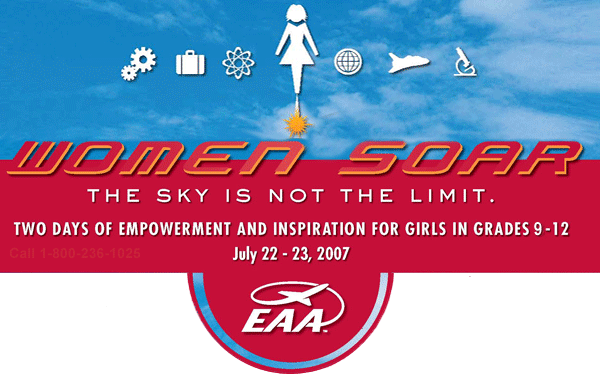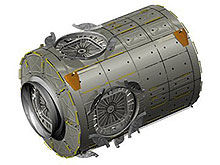| About Gail & VSEP | |
| Current Space Missions | |
> Space Education News & Links
|
|
Space Education News
(Scroll down for more items. Hot items for "back to school": Be sure to minimally read all the way through including the July 11 postings--but the other postings are still relevant and "live", too.)
May 25, 2012 Update
Frequent information, resources and Internet links related to sled dogs and space education are still being posted on Facebook and Twitter (@9dognight).
Nine months later, and sad to report, but our January 2012 update is still correct. If we're lucky, maybe the rebuilding, reconstructing, etc. will be done by the Aug. 28th one year anniversary of Tropical Storm Irene. Time will tell. None-the-less, we have no programs or skijoring gear to offer to the public right now or this spring/summer season.
We appreciate the contacts and interest we've received from folks via the phone and email. We are sincerely disappointed and really sorry that we can't accommodate the requests for summer programs for libraries, camps, etc. We hate to have to turn them down but have no choice right now! Time and energy is limited. Gas prices and dog truck repairs are expensive. When it rains it pours--but the good news is that our 7 dogs and 1 cat are happy and well. The 2 alpha humans here still laugh, smile and have gratitude, knowing we're lucky and fortunate. There are lots of folks hurting with truly horrible, enormous losses. We're not complaining--just explaining.
EDUCATOR CALENDAR
MARCH - JULY 2009 (DETAILS FOLLOW BELOW THIS CALENDAR LISTING)
March 2: Project Budburst 2009 Field Campaign Begins
March 6: Deadline to apply for tuition subsidies and travel grants for summer science workshops at Penn State University (educators of grades K-12)
March 9-13: Solar Week March 16-18: GLOBE at Night Campaign (Constellation Orion)
March 19: Professional Development Webcast (teachers grades 3-8): Solar Radiation and the Atmosphere
March 19: Webcast: Earth and Mars: A Tale of Two Planets, 11 a.m. – 12:30 p.m. EDT
March 20: Sun-Earth Day
March 25: Kepler Mission Videoconference April 6: Thacher Scholar Entries Due – contest for grades 9-12, for student projects using geospatial technologies to study Earth.
April 9: Webcast: Global Warming: Causes and Consequences, 11 a.m. – 12:30 p.m. EDT
April 19: Professional Development Webcast (teachers grades 3-8): Tides
April 29: Videoconference – Meteorology: An Educator’s Resource Guide for Inquiry-Based Learning
April 30: NASA Quest—LCROSS Student Projects Due
May 15: No Boundaries Competition Entries Due
May 27: Videoconference – NASA Explores Virtual Worlds
May 31: Registration Deadline for Climate Discovery Online Courses
June 18: Professional Development Webcast (teachers grades 3-8): The Story of Ocean Heat Storage
June -August 2009 Summer Science Workshops for K-12 Educators at Penn State University (open to educators from any state)
ACKNOWLEDGEMENTS: Information courtesy of NASA Science Mission Directorate
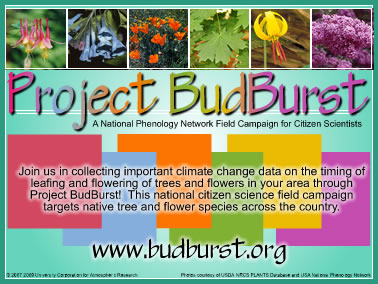
PROJECT BUDBURST BEGINS MARCH 2
Signs of Spring will eventually come to Vermont--but when? Is climate change effecting the timing? Have your students observe and record the first signs and contribute the data to an online site.
In 2008, thousands of people of all ages participated by taking careful observations of the phenological events such as the first flower, first leaf, and seed or fruit dispersal of a diversity of tree and flower species, including weeds and ornamentals.
New Web site features include field guides to phenophases, updated plant species Identification Guides, real-time mapping with Google Maps, new classroom resources, photo sharing of plant observations and more.
For more information, please visit the Project BudBurst Web site.
The site has lots of links and resources for educators.
SOLAR WEEK (MARCH 9-13)
![]()
Do your students have questions about the sun? During Solar Week students can submit questions to solar scientists via an online message board.
Solar Week provides a week-long series of web-based classroom activities and games geared for elementary, middle and high school students, with a particular emphasis on engaging girls in science.
The activities are a natural fit with 2009’s International Year of Astronomy, and introduce students to the Sun, solar telescopes, how the Sun is active, and solar energy.
Click here to explore the online resources and register to participate in Solar Week.
MARCH 20, 2009 SUN-EARTH DAY: OUR SUN, YOURS TO DISCOVER
NASA’s Sun-Earth Day Team is working to create yet another special event for “Sun Earth Day, Our Sun, Yours to Discover.” Sun-Earth Day is officially March 20, but plans are for a series of events leading up to that date and resources that can be used year-round. These include:
--New, monthly vodcasts for NASA’s Hinode mission,
--A new and improved Space Weather Action Center,
--A March 20 webcast (1:00 EST) with a panel of scientists and students monitoring the Sun and featuring exciting images and visualizations of the Sun.
Hinode has completed video production of its third vodcast. The project will be aired on YouTube March 7th, and will be the featured Sun-Earth Day 2009 video program on March 20 at the Sun-Earth Day Web site. The vodcast discusses the 20th Anniversary of the Quebec Blackout with filming in Montreal and interviews with Hydro-Quebec Power.
Click here for the latest information on these and other upcoming events and resources.
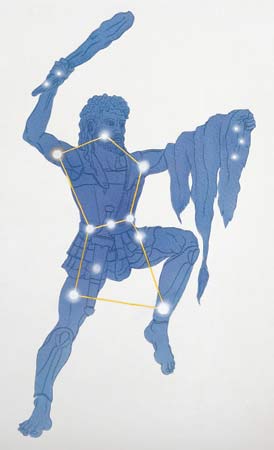
Orion, the hunter, showing the stars of the constellation Orion. Daniel Pyne—Dorling Kindersley/Getty Images (media-2.web.britannica.com/)
March 16-28: CAN YOUR STUDENTS FIND ORION IN THE NIGHT SKY? GLOBE AT NIGHT CAMPAIGN
March 16-28 are the two weeks when the Orion constellation is most visible around the world with naked eyes.
The GLOBE at Night Campaign is an international star-hunting project for students, teachers, and the general public. This year it will take place March 16-28, 2009.
Students can find their latitude and longitude, find Orion at night and match their observations to a magnitude chart. After, students report their observations online and can compare their observations with those from around the world.
We Vermonters are very lucky because it's not hard for any of us to escape the "city lights" to find great dark spaces for amazing views of the stars and constellations. However, folks living elsewhere aren't as fortunate. Because of the ambient light of urban landscapes, many city dwellers have never seen a sky full of stars.
The 2008 campaign received measurements from 62 countries and the final data sets are now available on their web site. For more information, click here.
EARTH SCIENCE WEBCAST SERIES FOR TEACHERS (GRADES 3-8) from NASA and NOAA
Five monthly webcasts will address a different Earth system science topic. The webcasts may be accessed on the NASA Digital Learning Network. RED, BLIND LINK: http://dln.nasa.gov/dln/.
NASA Langley Research Center - in co-operation with NOAA and the Virginia Department of Education Region 2 Math/Science Coalition - will offer a series of professional development programs for teachers of grades 3-8 .
Upcoming Webcasts:
March 19: Solar Radiation and the Atmosphere (4:00-5:30pm EST)
Apr. 16: Tides (4:00-5:30pm EST)
June 18: The Story of Ocean Heat Storage (4:00-5:30pm EST)
MORE NASA WEBCASTS: NASA LANGLEY / NATIONAL ALLIANCE OF BLACK SCHOOL EDUCATORS LECTURE SERIES FOR 2009
Join NASA's Langley Research Center and the National Alliance of Black School Educators for a series of free, interactive programs that allow you and your students to learn more about our home planet and the universe beyond. Click here for more information about these webcasts and videoconferences, and to submit questions to be answered during the events.
Upcoming Webcasts:
March 19: Earth and Mars: A Tale of Two Planets, 11 a.m. – 12:30 p.m. EDT
April 9: Global Warming: Causes and Consequences, 11 a.m. – 12:30 p.m. EDT
NASA SPACE SCIENCE VIDEOCONFERENCES FOR EDUCATORS
To assist educators in staying current on NASA education resources and related products, NASA’s Digital Learning Network presents a series of videoconferences.
During each event, product producers, authors and experts will demonstrate their materials designed to optimize awareness and understanding of science concepts. Instructional objectives, accessing the materials and primary contacts for the materials will also be discussed.
During the videoconferences, participants will be able to submit questions to the presenter that will be addressed during the presentation.
Upcoming events:
March 25: Kepler Mission, 4-5 p.m. EST
April 29: Meteorology: An Educators Resource Guide for Inquiry-Based Learning, 4-5 p.m. EST
May 27: NASA Explores Virtual Worlds, 4-5 p.m. EST
Click here for more information about these videoconferences and to sign up online.
THACHER SCHOLAR CONTEST:
for grades 9-12 Student projects using geospatial technologies to study Earth. Thacher Scholar Entries Due: April 6
Click here for more information.
NASA Quest -- LCROSS: Exploration Through Navigation Challenge Part II Student Projects Due: April 30
This challenge requires students to chart a course from NASA’s Kennedy Space Center at Cape Canaveral, Fla., to one of the lunar poles by using navigation skills appropriate for outer space. Other activities include weekly challenge questions (with prizes), an opening and closing webcast, and a chat with the author of "A Man on the Moon." Background materials and an educator's guide are available.
Registration is open now, and student projects are due April 30, 2009. Participation in Part I of the challenge, which was held fall 2008, is not required for participation in Part II. The two parts of the challenge complement each other but ultimately stand alone. Click here for more information about the challenge and to register online.
NO BOUNDARIES NATIONAL COMPETITION FOR HIGH SCHOOL STUDENTS Entry Deadline: May 15, 2009
NASA has teamed with USA TODAY Education to create the "No Boundaries" project and national student competition. This project is designed to help students explore careers in science, technology, engineering and mathematics. The No Boundaries Web site has a Teacher Toolkit and step- by-step instructions for teachers to implement the project in their classrooms. Students research and develop projects (podcast, Web site, newspaper, songs, artwork, etc.) marketing NASA STEM careers to teens and are encouraged to enter their projects in the No Boundaries National Competition. The contest deadline is May 15, 2009. Click here for more information.
CLIMATE DISCOVERY ONLINE COURSES FOR EDUCATORS Early Registration deadline: May 31, 2009
The National Center for Atmospheric Research (NCAR) offers a series of seven week online courses for middle and high school teachers that combine geoscience content, information about current climate research, easy to implement hands-on activities, and group discussion.
There is a $225 fee per course (save $25 if you register by May 31). The courses run concurrently from June 18-August 9, 2009.
CD 501 Introduction to Earth's Climate
CD 502 Earth System Science: A Climate Change Perspective
CD 503 Understanding Climate Change Today
For complete course schedule and registration information, visit http://ecourses.ncar.ucar.edu
SUMMER 2009--SCIENCE WORKSHOPS FOR K-12 EDUCATORS--COMPETITIVE GRANTS
Grants are awarded to all participants to cover lodging, meals, and partial travel. Tuition subsidies are available for all workshops on a competitive basis.
Tuition subsidies are available for ALL of the workshops, but they are competitive. Subsidies are awarded based on need as shown in your Letter of Interest and Letter of Support (see below). Subsidies are also granted on a first-come, first-served basis.
APPLICATION DEADLINES If you are requesting a tuition subsidy for any of the workshops, March 6, 2009 is the deadline for applications. If you are not requesting a subsidy, applications will be accepted through May 31, 2009. Notification of tuition subsidies will be sent on March 16, 2009.
June-July 2009: Penn State University is offering six science workshops for K-12 educators in the summer of 2009.
Participants will keep pace with the latest science research, engage in standards-based classroom activities, and explore ways to make science fun as they work side by side with Penn State faculty. Network with peers and earn 2 graduate credits and PA ACT 48 hours. The courses are aligned with the National Science Education Standards and Pennsylvania Standards for Science and Technology.
Grants are awarded to all participants to cover lodging, meals, and partial travel. Tuition subsidies are available for all workshops on a competitive basis. For more information on workshop contents, or to apply for one or more workshops, visit: http://teachscience.psu.edu
Earth’s History: Interaction Between Life and the Environment, June 28-July 2, Educators Grades 6-12
Exploring Renewable Energy Technologies and the Materials that Make it Happen June 28-July 2, Educators Grades 9-12
Calculator-Controlled Robots: Hands-On Mathematics and Science Discovery (NEW), July 12-17, Educators Grades 6-
Lunar Exploration (NEW), July 19-24, Educators Grades K-8
Extreme Cosmic Messengers, July 26-31, Educators Grades 9-12
Black Holes: Gravity’s Fatal Attraction, August 2-7, Educators Grades 6-12
The workshops are an outreach program of NASA’s Pennsylvania Space Grant Consortium, the Eberly College of Science, the College of Earth and Mineral Sciences, the National Science Foundation (NSF), and NASA.
NASA ENDEAVOR FELLOWS – PROJECT EXTENDED TO WINTER 2010
The NASA Endeavor Science Teaching Certificate Project awards one-year fellowships each year to over 40 current and prospective teachers. Funding authorization for the Project is provided through the NASA Endeavor Teacher Fellowship Trust Fund as a tribute to the dedicated crew of the Space Shuttle Challenger.
The NASA Endeavor Science Teaching Certificate Project funding has been extended one semester, delaying the Cohort 2 application process by a semester.
Applications will be accepted beginning Spring 2009 into Fall 2009 and announcements will be made in Fall of 2009. Cohort 2 will not begin in Fall 2009 as initially announced. Rather, Cohort 2 will now begin in Winter 2010 (January 2010).
Click here for more information at the project Web site.
NASA EDUCATIONAL RESOURCES
NEW DO-IT-YOURSELF PODCAST ACTIVITY FOR STUDENTS
The Do-It-Yourself Podcast activity sets the stage for students to host a science show. Students download NASA video or audio clips of astronauts training for missions, doing experiments or demonstrating equipment, and use them to build their own podcast or similar audio/ video project.
Learning modules on the Web site are categorized by topic, and each subject module includes video and audio clips, images, helpful information and links to related resources. Educators and their students are encouraged to distribute their NASA projects through podcasts, social networks, Web sites, CDs, DVDs or other channels that they may choose.
Click here to learn more and to start making podcasts.
NEW SPACE MATH PROBLEMS
Space Math @ NASA has posted 15 new problems. This quarter, the problems feature data and interesting issues from the STEREO, Hubble, Dawn, LRO and Hinode missions. Space Math @ NASA is also continuing to integrate math problems into the Sun-Earth Day Technology Through Time essays.
Click here to check out the new Space Math problems.
NASA AND GOOGLE LAUNCH VIRTUAL EXPLORATION OF MARS
On Feb. 2, NASA and Google announced a new Mars mode in Google Earth that brings a high-resolution, three-dimensonal view of the Red Planet to your desktop. Users can fly virtually through canyons and mountains, explore the planet through eyes of the Mars rovers and see the latest satellite imagery from NASA’s Mars Reconnaissance Orbiter.
Visit the Google Earth Web site at: http://earth.google.com/.
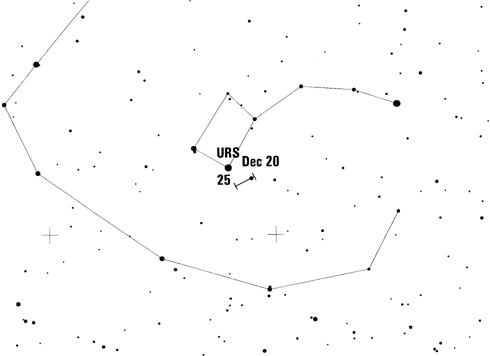
Posted on Mon., December 22, 2008
SKY WATCH
ALERT--URSID METEOR SHOWER PEAKS TONIGHT!
Happy Solstice!
Winter officially arrived yesterday!
If you have clear skies tonight (instead of a snowstorm) look to the Little Dipper constellation for the Ursid meteor shower.
URSID METEORS: Earth is currently orbiting through a stream of debris from comet 8P/Tuttle which causes the annual Ursid meteor shower.
Astronomers expect the Ursids to peak on Dec. 22nd with 8 to 10 meteors per hour flying out of the constellation Ursa Minor (the easily recognizable “Little Dipper” constellation which is not far from the North Star (Polaris).
While 8-10 meteors per hour is “no big deal” as far as really dramatic meteor showers go, sometimes the Ursids surprise observers and put on a really great show--with many more “shooting stars” seen than its normal rate. The last time this happened was in 2006.
With Vermont’s temperatures dropping rapidly to sub-zero tonight, plus the wind chill, bundle up in many layers, wear your hat, mittens and warmest socks and boots, bring a thermos of hot tea or hot chocolate and a chair and head outdoors into a safe, “dark sky” viewing area.
To light your way, especially through the deep snow, use a flash light with a red bulb or affix red cellophane over the flashlight bulb with a rubber band. That will give you better “night vision” in a shorter rate of time so you can start counting and enjoying the Ursids “festival of lights” show.
--end--
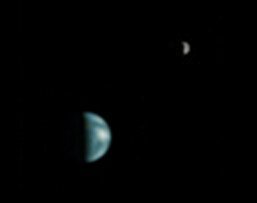
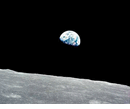
Posted on Mon., December 22, 2008
NASA TELEVISION COMMEMORATES APOLLO 8 CHRISTMAS EVE BROADCAST
with special programming Dec. 24 and 25 on the NASA TV Public Channel (101).
This week marks the 40th anniversary of the historic Christmas Eve broadcast by the Apollo 8 crew: Frank Borman, Jim Lovell and Bill Anders.
At the time, it created some controversy and made for some interesting discussions about the “pros” and “cons” of the unexpected spiritual, religious oriented broadcast from space (via tax dollars) that Christmas eve. But any astronaut who has left the confines of Earth’s gravity, has orbited Earth and especially for the very lucky few who traveled to our moon (either to orbit or walk on her surface called “regolith”), will tell you that they have been deeply moved and profoundly, forever effected by that majestic view and “other worldly” experience. (Some scientifically, some religiously, some spiritually or a combination of some or all.)
So whether or not you are religious or spiritual, you might wish to share some of NASA’s history via this week’s special program broadcasting on NASA TV (available online or via satellite dish or cable TV). You might wish to experience this with your family--especially the children who are far too young to have experienced this. (Many of us “boomers” and older seniors remember when this happened “live”.)
Why is this historic? important?
* Forty years ago, the 3-member crew became the first humans to successfully orbit around another celestial body. They orbited the moon in their Apollo 8 spacecraft.
* They were the first to capture on film the iconic image of beautiful Earth rising over our moon.
* On Dec. 24, 1968, the three astronauts devoted one of their mission’s six live television transmissions to reading from the biblical book of Genesis during what has since come to be known as “the Christmas Eve Broadcast” . (Yes, this did cause a bit of “pro and con” controversy.)
To commemorate the anniversary, NASA TV will air some special programs featuring Frank Borman, Jim Lovell and Bill Anders. Former U.S. senator and NASA astronaut John Glenn provided their introduction at one recent event this past November 2008. The various programs include footage documenting the Apollo 8 mission’s Christmas Eve broadcast, recent panel discussions with the three Apollo 8 astronauts and a short documentary of them describing their mission.
* Click here for program times and full listings.
-end-
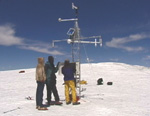
PROFESSIONAL DEVELOPMENT FOR MIDDLE AND HIGH SHOOL TEACHERS: INTERNATIONAL POLAR YEAR (IPY STEM Polar Connections)
WHO: Middle and High School Teacher Opportunity
WHAT: IPY STEM Polar Connections (International Polar Year: Science, Technology, Engineering, and Mathematics Polar Connections)
WHERE: University of Massachusetts (Amherst, Massachusetts)
WHEN: July 14-18, 2008
Application Deadline: Tuesday, 1 April 2008
CLICK HERE for further information.
PROFESSIONAL DEVELOPMENT TRAINING IN VERMONT: FOR K-2, 3-4, 5-8 EDUCATORS
VSEP can also provide professional development workshops in Vermont, related to sled dog education, IPY, science of snow, etc.--as well as space education. Email VSEP if you are interested:
Do you want to have your students: Conduct a Lunar Plant Growth Chamber Design Challenge? Conduct a scientific study using tomato seeds and/or cinnamon basil seeds?
Are you in need of more ideas and resources to use in your classroom that relate to the Grade Expectation Clusters you need to address? Email VSEP if you are interested.
Posted on March 25, 2008:
Earth Day Photo Contest for Middle School Students (Grades 5-8, USA)
WHO: The Institute for Global Environmental Strategies (IGES)is sponsoring an Earth Day photo contest for middle school students.
WHEN: Entries must be received by e-mail or postmarked by May 9, 2008.
WHAT: Interested students are asked to photograph something that is changing in their local environment.
The contest is open to all U.S. students in grades 5-8.
Students must take the photo between Tuesday, April 22, and Tuesday, April 29.
The change could be occurring in the student's backyard, outside the student's school, in a local park or even off in the distance.
Participants must research and write an explanation of the change documented in the photograph.
HOW: CLICK HERE for more detailed information about the contest, how teachers can use it in the classroom, download an entry form and how to submit the entries.
If you have questions about the contest, please e-mail your inquiries to info@strategies.org.
EDUCATOR CONFERENCE in California--June 14-15,2008:
Ocean Surface Topography Mission/Jason-2 Satellite Launch
WHERE: The Endeavour Center, NASA Educator Resource Center at Vandenberg Air Force Base, located in central California, will host an educator conference.
WHEN: June 14-15, 2008
WHY/ WHAT: This conference will coincide with the launch of the Ocean Surface Topography Mission/Jason-2 satellite launch on June 15, 2008.
The satellite will provide global ocean surface topography, circulation and tide models. This information is critical in the study of global weather because ocean temperatures and circulation drive many Earth weather cycles.
Registration and application information will be e-mailed to interested K-12 teachers. CLICK HERE for more information about this conference.
Update: February 1, 2008 "Across the Universe Day" to be Celebrated Musically on February 4, 2008 (NASA's 50th Birthday)
NASA has announced that "For the first time ever, NASA will beam a song -- The Beatles' "Across the Universe" -- directly into deep space at 7 p.m. EST on Feb. 4."
The choice of song is quite significant: February 4th is the 40th anniversary of the day The Beatles recorded the song as well as the 50th anniversary of NASA's beginnings. The title of the song states where the song will be beamed on Feb. 4, 2008: deep into space via NASA's Deep Space Network. (The Deep Space Network is an international network of antennas that supports missions to explore the universe.)
Two other anniversaries also are being honored: The launch 50 years ago this week of Explorer 1, the first U.S. satellite, and the founding 45 years ago of the Deep Space Network.
Beatles fans have proclaimed Feb. 4 to be "Across The Universe Day". As part of the celebration, the public around the world has been invited to participate in the event by simultaneously playing the song at the same time it is transmitted by NASA.
The musical transmission is being aimed at the North Star, Polaris, which is located 431 light years away from Earth. The song will travel across the universe at a speed of 186,000 miles per second. Former Beatle Sir Paul McCartney expressed excitement that the tune, which was principally written by fellow Beatle John Lennon, was being beamed into the cosmos.
NASA's Jet Propulsion Laboratory in Pasadena, Calif., operates the Deep Space Network.
Update for February 1, 2008: Here Comes the Sun/Earth Day!
March 20, 2008, is the official date for "2008 Sun-Earth Day." Not just a one day only event, this year's theme is "Space Weather Around the World". Sun-Earth Day is designed to be a combination of programs and events throughout the year ending with a Sun-Earth Day celebration on or near the Spring Equinox in March.
Updated on Jan. 29, 2008:
NASA Quest Challenges Announced for Spring 2008
NASA has announced two new education challenges for the spring of 2008 and a new mathematics unit for students in grades 6-9.
WHAT: Cratering the Moon Challenge From NASA Quest
The Lunar Crater Observation and Sensing Satellite mission will search for water ice at the south pole of the moon. Finding deposits of water ice would be a crucial step in deciding where to locate a human outpost on the moon. In this challenge, students are must design a lunar impact simulator and determine the optimal impact angle to get the most information from the impact.
WHO: Students in grades 6-9
WHEN: Registration begins in February 2008.
Click here for background references.
WHAT: Antarctic Quest Challenge for Grades 5-14 (March-May 2008
In this challenge, students become scientists and propose Antarctic research. The Landsat Image Mosaic of Antarctica is the first true-color high-resolution satellite view of the Antarctic continent. Using this view of Antarctica, students must develop a research question and debate the value of studying the chosen feature.
WHEN: Registration is expected to begin in March 2008.
Click here for new resources to get ready for the challenge. New resources will continue to be added.
WHAT: Moon Math! (for students in grades 6-9)
Moon Math! is a set of two mathematics units. The units are centered on the theme of lunar habitat design. Each unit is supported by paper-and-pencil activities, as well as an interactive software application. All lesson plans and software applications for these units are free and can be downloaded.
POSTED DEC. 14, 2007:
Register Today for 3 FREE IPY/NSTA Web Seminars -- Arctic and Antarctic Living Systems (Provided by NASA/ NOAA/ NSF/ NSTA)
How can you beat a free seminar? How about 3 free seminars? Read on!
WHO: Educators of grades 5-8
WHEN: The Web seminars in this series are scheduled for Dec. 30, 2007, Jan. 17 and Jan. 24, 2008. Each seminar will begin at 6:30 p.m. EDT.
WHAT: Join NASA, the National Oceanic and Atmospheric Administration, the National Science Foundation and the National Science Teachers Association for three, FREE Web seminars on the topic of the International Polar Year. Designed for educators of grades 5-8, the seminars will focus on land and marine adaptations to extreme conditions, species migration, and the role of humans in polar ecosystems. The presenters will share their expertise, answer questions from the participants and provide information regarding Web sites that students can use in the classroom.
The Web seminars are 90-minute, live professional development sessions that use online learning technologies to allow participants to interact with nat ionally acclaimed experts, scientists, engineers and education specialists funded by NASA, NOAA and NSF. Each Web seminar is a unique, stand-alone program. Archives of the Web seminars and the presenters’ presentations will be available online.
* For more fun, contact Atii Sled Dogs to add a sled dog education program for your students to supplement the info you learn from the free online NASA/NOAA/NSF/NSTA seminars.
* There is a cost to bring Atii Sled Dogs programs to your classroom (experienced sled dogs and educator/musher, sled, gear, and more). Contact Atii directly for that info.
HOW: Register Today for IPY/NSTA Web Seminars -- Arctic and Antarctic Living Systems. Online registration for each is now open.
*** To schedule an Atii Sled Dog program for your classroom, contact Atii directly for that info. Please complete and return the linked form to Gail at AtiiSledDogs@madriver.com.
POSTED DEC. 14, 2007:
Spaceward Bound Fieldwork Opportunity for College Students
WHO: College students: upper-undergraduate and graduate levels
WHY: Spaceward Bound is an educational program designed to train the next generation of space explorers.
WHAT: Students participate in the exploration of scientifically interesting but remote and extreme environments on Earth as analogs for human exploration of the moon and Mars. This program enables college students to participate as crew members in two-week-long immersive, full-scale simulations of living and working on the moon and Mars at the Mars Desert Research Station (MDRS). Each Spaceward Bound MDRS participant receives a $500 stipend toward travel expenses.
WHEN: The Spaceward Bound crew rotations at MDRS take place from October to March each year. They are currently planned through 2010. HOW: Applications for these expeditions are available through The Mars Society, which established and operates the Research Station. Click here for more information.
*Spaceward Bound Fieldwork Opportunity for Students*
Spaceward Bound is an educational program designed to train the next generation of space explorers. Students participate in the exploration of scientifically interesting but remote and extreme environments on Earth as analogs for human exploration of the moon and Mars.
The student program enables students at the upper-undergraduate and graduate levels to participate as crew members in two-week-long immersive, full-scale simulations of living and working on the moon and Mars at the Mars Desert Research Station. The Spaceward Bound crew rotations at MDRS take place from October to March each year. They are currently planned through 2010.
Applications for these expeditions are available through The Mars Society, which established and operates the Research Station. Each Spaceward Bound MDRS participant receives a $500 stipend toward travel expenses.
For more information, visit here.
Posted November 15, 2007:
21st Century Explorer Podcast Competition
Who: Students ages 11 to 18
When: Deadline of Jan. 4, 2008
What do you think is NASA's greatest exploration achievement in the past 50 years, and why? That is the question NASA is asking students for the Second Annual 21st Century Explorer Podcast Competition. Students will create an audio recording or video -- running one minute or less -- with their answer to the question.
The contest is open to U.S. citizens, ages 11 to 18. Entries will be judged on content, creativity, execution, clarity and overall impression. The 15 finalists in each format (audio and video) and each age category (ages 11-14 and ages 15-18) will be displayed on the contest Web site, where the public will vote for and select a "People's Choice" winner. Prizes will also be awarded for first, second and third place. Winners will be announced on the Web site Feb. 28, 2008.
Entries are being accepted now through Jan. 4, 2008, or when the first 1,000 entries in each category are received.
Click here for more information, including tips for creating audio and video podcasts.
Posted November 15, 2007:
Aeronautics Competitions for High School and College Students (2007-2008)
NASA has announced a new aeronautics competition for high school and college students for the 2007-2008 academic year.
Who: High school and college students
When: Notice of intent to participate for high school entries is due on Dec. 15, 2007. Notice of intent for college entries is due on Jan. 19, 2008.
What: High school students are challenged to write a research paper to explain ideas for a future aircraft that could become the "DC-3" for cargo and passengers in the year 2058. Descriptions should be well-informed and include sections on fuel, environmental effects, noise levels, runway length and condition, operating costs, passenger and cargo loads, and service operations. Notice of intent to participate for high school entries is due on Dec. 15, 2007.
What: College students are invited to design the next generation, 21'st-century, "DC-3"-type aircraft. Some of the design considerations include reduced environmental impact, reduced noise, daily operations on short runways, cost analysis for production and operation, passenger and cargo limits, structure and materials, and engines. Students should also briefly describe three valid scenarios for potential use of this vehicle in the year 2058. Notice of intent for college entries is due on Jan. 19, 2008.
Any U.S. student enrolled in an accredited high school, secondary school, or home school in the United States or its territories is eligible to enter the competition for cash prizes. Non-U.S. citizens and students in international locations can enter as well, but they are not eligible for cash prizes. Trophies and certificates will be awarded to each winner, regardless of citizenship.
Click here for complete details.
POSTED OCT. 16, 2007:
NASA 50th Anniversary Essay Contest for Students
The NASA 50'th Anniversary Essay Competition for middle and junior high school students is now accepting entries. The competition consists of two separate topics, each with a limit of 500 words. The first topic challenges students to describe how they benefit in their everyday lives from space technologies built by NASA over the last 50 years. The second topic requires students to imagine how their everyday lives will have changed because of NASA space technology in the next 50 years.
Students may submit two separate essays, each responding to a separate
topic. Participants must be U.S. students in grades 5-9 and under the age of 15. An optional notice of intent is due on Dec. 7, 2007. Final entries are due on or before Jan. 7, 2008.
Click here for more information.
POSTED OCT. 16, 2007:
NASA Undergraduate Student Research Program Spring 2008 Internship Session
NASA's Undergraduate Student Research Program is currently accepting applications for 15-week spring 2008 internships. These internships offer students the opportunity to work alongside NASA scientists and engineers at NASA's centers, laboratories and test facilities.
Applicants must be U.S. college sophomores, juniors or seniors with majors or course work concentration in engineering, mathematics, computer science, or physical or life sciences.
Applicants must be U.S. citizens. The application deadline for the spring 2008 session is Oct. 22, 2007.
Click here for more information.
NASA EXPLORING SPACE CHALLENGES
2007-2008 CHALLENGES
OCT. 9, 2007: Registration Deadline Extended for NASA's "Exploring Space Challenges" Program
NASA has announced that their registration deadline for three of the Exploring Space Challenges (2007-08) has been extended to Oct. 14, 2007.
These challenges are designed to help students develop computer and Internet skills, learn to communicate more clearly and effectively, and work collaboratively as team members.
The following challenges are now open:
1) Mission: Hurricanes -- Grades 6-8
Here's an opportunity for students to become hurricane detectives! NASA scientists follow the clues that are left behind by these storms. Students have the opportunity to consult with a NASA scientist or educator, analyze NASA data, and communicate their findings.
Click here for more information.
2) Mission: Habitat Moon -- Grades 3-12
Within the next decade, humans will once again return to the moon. The ultimate goal is to build a base to live and work on the moon. Mission: Habitat Moon wants your students to play the roles of the first engineers and scientists on the moon. Student engineers can design and construct an enclosed habitat of their own, as well as monitor its maintenance.
Click here for more information.
3) Mission: Moon Math -- Grades 5-8
This challenge is an opportunity for students to complete a scientific investigation related to NASA's efforts to return to the moon by 2020. Students will work in teams of two to design, build and conduct an experiment on some aspect of the moon. All projects must incorporate measurement.
Click here for more information.
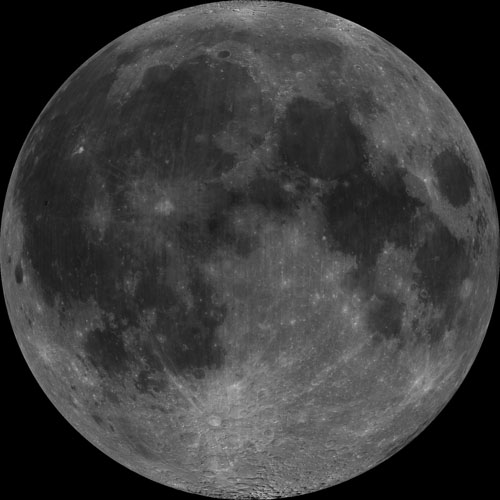
HARVEST MOON: I hope you all got to see the gorgeous full Moon on Wed. night, Sept. 26. The full Moon closest to the autumnal equinox is named the "Harvest Moon" because in "days of old" farmers relied on moonlight to help them gather ripening autumn crops and work late into the night. I actually did this last night as I harvested tomatoes, broccoli and zucchini from my garden. (Have your students learn the other names and multi-cultural tales about each full moon.)
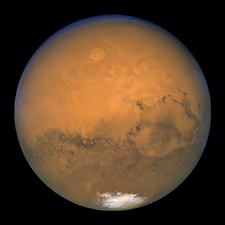
Photo of Mars taken during Aug. 2003 by the Hubble Space Telescope. (Credit: NASA)
Register Today for FREE JPL/NSTA Web Seminars
(For Educators: grade 5-12; Topic: Mars Exploration)
Posted: Thurs., Sept. 27, 2007
Received from NASA: Wed, September 26, 2007
NASA's Jet Propulsion Laboratory is collaborating with the National Science Teachers Association to develop a series of FREE Web seminars for grade 5-12 science educators on the topic of Mars Exploration.
The Web seminars are 90-minute, live professional development sessions that use online learning technologies to allow participants to interact with nationally acclaimed experts, scientists, engineers and education specialists from NASA. The Web seminars are conveniently scheduled so that educators from all U.S. time zones may participate, and no travel is required. Each web seminar is a unique, stand-alone program. Archives of the Web seminars and the presenters' PowerPoint presentations will be available online.
Upcoming JPL/NSTA Web seminars are listed below. Online registration for each is now open. All web seminars are scheduled from 6:30 p.m. - 8:00 p.m. Eastern time.
Oct. 4, 2007 -- JPL/NSTA Web Seminar: Using Earth to Explore Mars
(Click here to register)
Join Dr. Michael Meyer, Senior Scientist at NASA Headquarters, and Brian Grigsby from the Arizona State University Mars Education Program as they compare and contrast Earth and Mars. The seminar will highlight ways to familiarize students with planetary processes and landforms by integrating non-Earth examples. A Mars mission update will also be included.
Oct. 16, 2007 -- JPL/NSTA Web Seminar: How Science REALLY Gets Done
(Click here to register)
Join Dr. Philip Christensen, Regents Professor in Arizona State University's School of Earth and Space Exploration, as he shows teachers how scientists approach complex problems and ways to engage students' curiosity to help them think like scientists.
Nov. 29, 2007 -- JPL/NSTA Web Seminar: Robotic Engineering: Big Toys, Big Fun
(Click here to register)
Join Kobie Boykins, one of the engineers responsible for building the enduring Mars Exploration Rovers, for a look "behind the scenes" of what it was like to build the twin Mars rovers that are still exploring the surface of Mars.
Dec. 6, 2007 -- JPL/NSTA Web Seminar: Are We Alone?
(Click here to register)
Join Dr. Jack Farmer as he talks about astrobiology, extreme environments, some of the extreme places life has been found and the applications of these subjects to Mars exploration.
Tues., Aug. 28 8:15am--addendum
What a way to start the day! I hope you got to see the eclipse as it was gorgeous. I woke at 4:30am and hiked to one of my favorite higher elevation locations pre-dawn and had a fantastic view of the Earth's shadow creeping down over the full moon. The moon was well above the ridgeline of the beautiful green mountains of Vermont as Earth passed between the sun and our moon (Luna). I got to see the eclipse of the moon until it was about 99.5% shadowed in full totality as the moon dropped behind the mountains. Sunrise was spectacular as well: a "sky blue pink" morning with views of the fog rising and nestling in the lower elevations and on the valley floor and other cooler microclimate spaces. Fresh bear scat, singing birds, laden apple trees...what a beautiful, memorable Vermont morning!
Total Lunar Eclipse on August 28, 2007
For those of you who have students in class already, there is a total lunar eclipse pre-dawn that will be visible in Vermont for part of the time. (The moon sets in total eclipse.)
The eclipse begins at 5:52 am and ends at 7:22 am. However, here in the East sunrise is at 6:10am which means the moon will set then while in full totality as the sun rises--so tell the students to get up early and watch closely at 5:52 and continue until they can no longer see the moon.
* For the best viewing opportunity, it's recommended to go outdoors and be settled in a dark sky location minimally 30 minutes earlier to get your "night vision". Don't use a flashlight unless it has a red bulb or put red cellophane over the glass lens. Any other bright light colors, including white white or blue light, will interfere with your night vision.
* Naked eye viewing is fine and without danger of damaging eyes--until the sun rises and then looking directly at the sun for an extended period of time can hurt the eyes.
* You might want to have students make drawings of what they see--and if they have a camera, they can take photos as well.
* If they have access to binoculars or a telescope that adds to the viewing experience.
* If you have any time (ha!) click here for some links that will give you a variety of related resources for your content/ science background as well as activities to use with students:
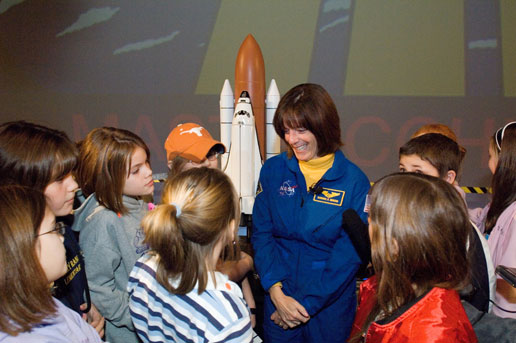 Photo: NASA
Photo: NASA
Click here for information on STS-118, Space Shuttle Endeavour.
This mission to the International Space Station will have the first educator astronaut, Barbara Morgan, flying with her crewmates. Morgan, a former 2nd-3rd grade teacher from Idaho, has been waiting and training for 21 years for her flight.
Launch currently (as of July 3) scheduled for evening of August 7, 2007.
Launch currently (as of August 3, 14:10 edt) scheduled for evening of August 8, 2007. Click here for more information.

UPDATED: Monday, August 20, 2007 7:00am
Registration is NOW open for the new NASA Engineering Design Challenge: Lunar Plant Growth Chamber (Educators of grades K-12)
NASA and the International Technology Education Association (ITEA) have teamed together to present the NASA Engineering Design Challenge: Lunar Plant Growth Chamber for the 2007-2008 school year.
Click here to register. The first 100,000 educators to register will be able to receive some of the cinnamon basil seeds that are aboard Endeavour with astronaut Barbara Morgan and the crew of mission STS-118. In order to obtain the seeds you must also do the engineering design challenge.
Click here to read more about "STS-118 Mission Specialist Carries Millions of Basil Seeds to Space, Brings Millions More Home for Students to Study"
Contact Vermont Space Education Program if you are interested in a related workshop.
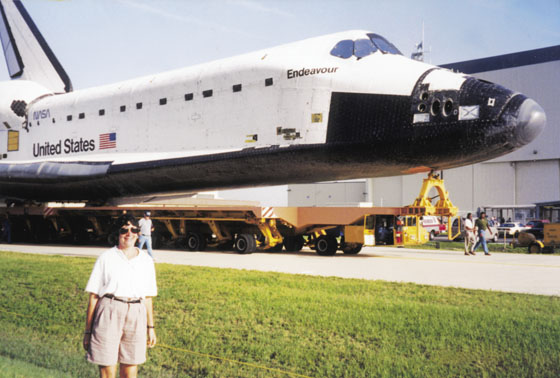
MESSAGE TO VERMONT EDUCATORS
For 22 years I have been trying to obtain a complete contact list for all the Vermont 1985 applicants for the "Teacher in Space Project" candidates--and have come up empty-handed.
The same is true for my efforts to obtain a complete contact list for all the educators honored as "Vermont Christa McAuliffe Fellows."
I have wanted to include each of those folks from both groups in many Vermont events as well as other opportunities I've been involved with--as well as have public recognition for each of them as Barbara Morgan's mission as Mission Specialist and the first Educator Astronaut approaches this August. (Currently scheduled for August 7, 2007)
If you know of, and are in touch with, any of the above folks, please forward this message to them.
To Vermont's Teacher in Space Project applicants (all 50+ applicants from 1985):
I want to be sure you know that you will be with me at this launch. Each of us, the 50+ Vermont applicants, all shared the passion, dream and desire to experience micro-gravity, see our planet while orbiting in a space shuttle at 17,500 mph and return to Earth to convey that experience to students and educators. You are always in my heart and mind as a special, small group of Vermont teachers who took a big chance towards fulfilling that special dream and vision. STS-118 is our mission, too.
To each of Vermont's Christa McAuliffe Fellows:
You were selected to receive funds for or to participate in a unique and exciting, exemplary education project or research you wanted to pursue or to serve as a mentor to other teachers in their classrooms. Your selection as a McAuliffe Fellow bonds you to Christa for her dedication and pursuit of creative, exciting education. By extension, it connects you to Barbara and this mission as well.
To All Vermont Educators:
I am well aware that those of you who were in the classroom in 1986 are sometimes still brought to tears about Christa's shuttle mission. And we all know Columbia brought us to tears as well.
I know there will be a variety of emotions with this particular launch for all of us. But this is an exciting mission--and an exciting accomplishment. Barbara Morgan, a woman who was an elementary school teacher, is an official, fully-trained astronaut. Among other mission assignments, she will be operating the robotic arm during construction of the International Space Station. She is not just a teacher doing education activities--she is the same as the rest of her crew-mates: a fully trained and competent astronaut!
This is a mission for education (even if the launch is occurring when many are still on summer hiatus.) Barbara Morgan has had this dream since she was a kid. There are lots of lessons that can be gleaned from this special mission.
Rest assured, Barbara Morgan is ready and excited to fly. She is truly an amazing, brilliant, accomplished woman; a dedicated, passionate, creative educator and a strong advocate for teachers and education. She is a fantastic representative of educators everywhere. (Yes, I've used a lot of superlative adjectives--but she is deserving of them--and more.)
I hope we can work together to find the proper venue (and financial resources to cover her travel costs as per NASA's requirements) to have her in Vermont as a keynote speaker. She's a great speaker and she'll have amazing stories and images after this flight! As you can imagine, her post-flight speaking engagement calendar is very full already. When the right opportunity comes along to maximize her presence, even though she is a good friend, I will still have to go through the proper NASA channels--but I have some "connections" to help.
Best regards and deep admiration for all you have done and continue to do for students, teachers and education. I'll be thinking of all of you while I'm at the launch.
Gail
July 11, 2007: Become a NASA Explorer School for 2008-2009
New Round of Applications being Accepted--DEADLINE is Jan. 31, 2008
Applications are now available for educators interested in joining NASA Explorer Schools during the 2008-2009 school year. Schools from the 50 states, the District of Columbia, Puerto Rico and the Virgin Islands may apply for the NES 2008-2009 school year. NES offers unique opportunities designed to engage and educate the future scientists who may someday advance U.S. scientific interests through space exploration.
Teams composed of full-time teachers and a school administrator develop and implement a three-year action plan to address local challenges in science, technology and mathematics education for grades 4-9. Schools that are selected are eligible to receive funding during the three-year partnership to purchase technology tools. The project also provides educators and students with content-specific activities that can be used within the curricula to excite students about science, technology, engineering, and math (STEM).
Applications are due Jan. 31, 2008. Click here for more information.
WOMEN SOAR: THE SKY IS NOT THE LIMIT
2 DAYS OF EMPOWERMENT FOR GIRLS IN GRADES 9-12
Do you have a 9th to 12th grade daughter or know a female teenager fascinated with all things that fly in the air or orbit in space, or who loves science or engineering? Perhaps she likes to draw designs of aircraft or maybe she has an interest in math and likes to figure out velocity. Maybe she went to Starbase Vermont, ACE Camp or Space Camp and is looking to add to those experiences. Maybe she wants to learn more about career opportunities in aviation or aerospace (many in Vermont.)
Is your daughter looking for an amazing two-day experience this summer where she will be inspired and motivated? Your daughter has a chance to apply for an opportunity that she will long remember. This could be the start of a career path.
DEADLINE: Submit an application BEFORE July 16, 2007 to Women Soar. You are responsible for paying/providing transportation to Oshkosh, Wisconsin.
WHO: Girls in grades 9-12
WHEN: July 22-23, 2007
WHERE: Oshkosh, Wisconsin
WHAT: On July 22-23, 2007, the Experimental Aircraft Association (EAA) will present Women Soar - The Sky is Not the Limit 2007. Held during EAA AirVenture Oshkosh - the World's Greatest Aviation Celebration - Women Soar will introduce girls in grades 9-12 to exciting career opportunities in the fields of math, science, and technology. The event will also highlight educational resources and inspire them to explore their potential. Proceeds will support scholarships to help girls pursue their dreams through EAA's education programs and activities.
The girls accepted into the program will start their adventure on Sunday afternoon, July 22, with an adventure ropes course. That evening there will be an exciting "launch" dinner. Anousheh Ansari, the first female civilian astronaut and sponsor of the Ansari X-Prize, will be there. Monday's events include breakout sessions and special presentations. There are amazing women mentors with a wealth of aviation and aerospace backgrounds and experiences for the girls to meet. The afternoon also includes time to visit AirVenture and see all the planes and exhibits.
FEE: Registration for this two-day event is $10 (scholarships are available). Registration fee includes Sunday dinner, breakfast, and lunch on Monday, along with an optional overnight camping experience coordinated by the Girl Scouts.
You will need to pay for and provide transportation to and from Oshkosh, Wisconsin and any other travel costs.
DETAILS/ APPLICATION: Visit Women Soar
A Personal Help Note:
Do you know of anyone flying to Oshkosh, Wisconsin for the AirVenture?
I've been invited to participate as a mentor for the 2-day program for girls in grades 9- 12, however, there isn't financial or travel support for the mentors. I'm looking for a free plane ride to and from there: hoping I can hitch a private plane ride with any experienced pilot who is flying there. Sorry, but I can't kick in for any fuel or flight costs. (I'm saving my money to get to Barbara Morgan's shuttle launch and be with my fellow Teacher in Space-Space Ambassadors.) I need to depart from Vermont to Oshkosh either Saturday evening, July 21 (after work) or early Sunday morning, July 22. I have to be there by 13:00 CDT if possible for the ropes course--or by 16:30 at the latest for the dinner and evening's events. I need to return to Vermont either Tuesday, July 24 or Wednesday, July 25.
Challenge your students. The NASA Exploring Space Challenges season has opened with the launch of "Name the ISS Node 2." K-12 educators may register their classes or school for various education challenges. Time sensitive deadlines apply so read carefully. The Vermont Space Education Program is available to help you include these challenges in your classroom. VSEP can provide related professional development workshops to help you with the content related to the challenges. Additionally, VSEP can provide related programs in the classroom to help students get background information related to the various challenge topics. These challenges fit in with standards. Contact VSEP for more information to schedule time to work with you in your classroom. Learn more about the challenges by clicking on this image of Node 2:
Challenge your students. NASA Exploring Space Challenges is a great high interest learning opportunity for your students. K-12 educators register their classes or school for various education challenges. Time sensitive deadlines apply so read carefully.
What will your students gain?
* Develop "science as inquiry" skills
* Work collaboratively as team members
* Apply computer and Internet skills
* Integrate science, mathematics and technology concepts
* Learn to communicate more clearly and effectively
Mission: Moon Math
Registration to open again AUGUST 2007
Grade Category: 5-8
Explore the Moon through measurement. Design an experiment, propose to NASA and collect data about the Moon.
Mission: Design a Lunar Base (K-4, 5-8): Submission Deadline was extended to April 6, 2007! Results expected in May, 2007
Mission: Teacher Challenge: Hurricanes! (pre-service and K-12 teachers): Results expected around June 2, 2007
The Vermont Space Education Program is available to help you include these challenges in your classroom. VSEP can provide related professional development workshops to help you with the content related to the challenges. Additionally, VSEP can provide related programs in the classroom to help students get background information related to the various challenge topics. These challenges fit in with standards. Contact VSEP for more information to schedule time to work with you in your classroom.
Learn more about the challenges by clicking on this image of Node 2:
"Name the ISS Node 2." The NASA Exploring Space Challenges (2006-2007) has results for this competition--and Node 2 has a new name!
Thanks to students from across the United States, Node 2 is now known as "Harmony". The name was chosen from a NASA academic competition (Exploring Space Challenge--posted on this site.)
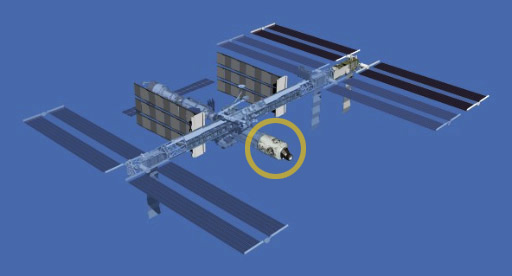
Computer-generated artist's rendering of the International Space Station after the Harmony connecting node (circled in yellow) is relocated from the Unity node port side to the forward port of the Destiny Laboratory. Credit: NASA
Six different schools in different states submitted the name Harmony. The name was selected because it represents the spirit of international cooperation embodied by the space station, as well as the specific role played by the module in linking the various modules created by the many international partners.
Students in kindergarten through high school from 32 states participated. The Node 2 Challenge required students to learn about the space station, build a scale model and write an essay explaining their proposed name for the module that will serve as a central hub for science labs.
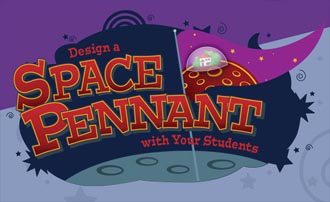
NASA Space Pennant Design Challenge (ages 6-12 years old)
ONLINE VOTING: scheduled to begin May 3, 2007
Help select the one lucky winner--who will be invited to attend the launch of Space Shuttle Endeavour- mission STS-118!
This challenge was created and run in collaboration by NASA, AOL's kids service KOL, and Mad Science.
This is more than an an art project! Students must research their topic, and use what they learn to design their pennant. Then, they must write essays explaining their designs. The essays must tell how the pennants reflect the research about STS-118 or the Vision for Space Exploration. (The Vision for Space Exploration is the program that will see humans return to the moon and then travel to Mars and beyond.)
The winning design will fly into space on the STS-118 shuttle mission, scheduled to launch in August 2007 (currently scheduled for August 9.)
As if that isn't cool enough, the winner will be invited to see the launch of STS-118 (with one parent/guardian)!
Ten semifinalists will be chosen in each of three age groups -- 6-8, 9-10 and 11-12. Judges from NASA, KOL and Mad Science will then select two finalists from each group. ONLINE VOTING: On May 3, those six finalists will be announced, and one overall winner will be selected through online voting.
Click here for more details.
Announcement of this challenge was made/received March 17, 2007. Deadline to submit entries: April 10, 2007
A few Vermont schools have applied. The names of the selected schools are expected to be announced in April or early May. Stay tuned for the announcement!
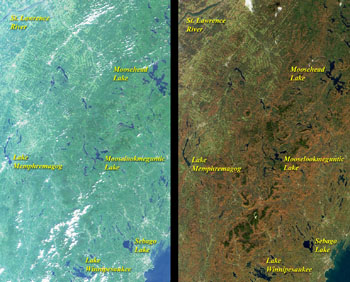
NASA Explorer School: Orleans Elementary School, Orleans, Vermont
UPDATE POSTED APRIL 2007:
Congratulations to Orleans Elementary School! They have been selected as one of the 25 new NASA Explorer Schools and now have a special three-year partnership with NASA and the NASA Goddard Space Flight Center in Greenbelt, Maryland! This news was released by NASA on May 11, 2007.
This VSEP site had posted information with additional links regarding this announcement of opportunity. Additionally, emails and media releases were sent to get the word out. Applications closed on January 31, 2007.
Targeting underserved populations in diverse geographic locations, NASA Explorer Schools will bring together educators, administrators, students and families in sustained involvement with NASA's education programs.
NASA Explorer Schools (NES) brings together a team of full-time teachers and a school administrator (Grades 4-9) in order to develop and implement a three-year action plan to address local challenges in science, technology and mathematics education. Multiple schools from the same district can form a consortium.
The NASA Explorer Schools project focuses on incorporating NASA content, data and materials into the schools' curricula at grades 4-9. Throughout the three-year commitment, educator teams implement their action plans, participate in professional development, and involve students and families in NES activities. This customized professional development plan will be available based on needs assessments and delivered through on-site school services and via distance-learning networks.
Click for the NES FAQ pdf file.
What are the benefits?
You have an ongoing relationship and contract with NASA for three years of mutual commitment—providing an incredible learning opportunity for educators, students and families.
A grant to each school will support the purchase of technology tools, online services and inservice support for the integration of technology applications to engage students in science and mathematics investigations.
The professional development training includes summer training at NASA Goodard Space Flight Center in Greenbelt, Maryland for the selected Vermont school teams. (The US is divided into regions, with states assigned to various field centers for service.)
Do we currently have any NASA Explorer Schools?
North Country Union Jr. High School in Derby was selected as a NASA Explorer School in 2003 and is now an alumnus of the program.
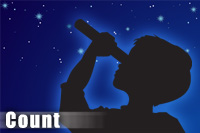
Star Count
NASA's Star Count project asks students to help answer the questions, "Do people everywhere see the same number of stars in the night sky? Why or why not?” This is an international project with students contributing their data—and observing the data contributed by other students from around the planet.
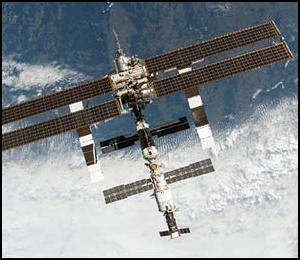
LIVE WEB EVENT ON FEB. 15, 2006:
HAVE YOUR STUDENTS WATCH AND LISTEN IN AS
NORTH CAROLINA STUDENTS SPEAK WITH SPACE STATION CREW on FEB. 15, 2006
High school students at the North Carolina School of Science and Mathematics in Durham, N.C. will speak with the International Space Station crew from approximately 9:37 to 9:55 a.m. EST, Wednesday, Feb.15, 2006.
The event will be live on the Web and NASA TV from the North Carolina School of Science and Mathematics (NCSSM.) It will also be archived and available for later viewing.
Expedition 12 Commander Bill McArthur and Flight Engineer Valery Tokarev will answer questions about their mission. North Carolina is McArthur’s home state, and he grew up in Robeson County. The Robeson Planetarium and Science Center will also participate in the downlink.
International Space Station downlinks are integral to NASA's Teaching from Space Program. It promotes learning partnerships using NASA research and technology, and it creates unique opportunities for students to interact with astronauts as they work in space.Vermont (and other) educators and students are invited to listen in.
NASA TV's Public, Education and Media channels are available on an MPEG-2 digital C-band signal accessed via satellite AMC-6, at 72 degrees west longitude, transponder 17C, 4040 MHz, vertical polarization.
In Alaska and Hawaii, they're on AMC-7 at 137 degrees west longitude, transponder 18C, at 4060 MHz, horizontal polarization.
-- Click here for NASA TV digital downlink information and access to NASA TV's Public Channel on the Web.
--Click here for information about the crew and the space station.
--For a video stream of the hour long event originating at NCSSM from 9:15-10:15 AM, live on February 15th, and archived there for later viewing, go to the NCSSM.
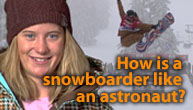
February 10, 2006
DO YOUR STUDENTS HAVE OLYMPIC FEVER? TIE IT INTO SPACE EDUCATION!
NASA AND OLYMPIC ATHLETES PLAN LUNAR GAMES
With the help of several Olympic athletes, students can get a physics lesson from NASA about potential winter sports on the most extreme venue around -- the moon.
U.S. Olympic snowboarder Hannah Teter from Belmont, Vermont, skier Eric Bergoust, bobsled team member Todd Hays and U.S. Snowboard team member Kier Dillon are featured in 30-to-60-second NASA TV clips that explore the scientific concepts of their winning flips and rips.
The educational segments are available for public use. They air on NASA TV and the segments can be viewed or downloaded from the Web.
Teter shows how her skills to hit a front side five might be used to land a lunar spacecraft. Bergoust explores whether he could double his quadruple-twisting flip with a perfect landing in the moon's one-sixth gravity. Hays uses rocket launches to jump start his bobsled, and Dillon investigates the differences between riding lunar and Earth slopes.
"U.S. Olympic athletes are helping to educate our youth by comparing the physics of sports with the physics of space exploration," said Phil West, NASA's Johnson Space Center acting director of education. "We hope parents and teachers will use the clips to interest teens in math and science, because America will need them to become tomorrow's inventors."
With mountains rivaling the Rockies, lower gravity and dust that looks like snow, the moon has potential. Today's athletes aren't the first to notice. When Apollo 17 geologist Harrison "Jack" Schmitt landed on the moon in 1972, moving around reminded him of skiing. "I think downhill techniques would work very well on the moon," Schmitt said. "You even have built-in moguls, the impact craters on the slopes. Lunar gravity would allow all kinds of jumps and hops that you might find difficult on Earth."
Click here for educational stories about potential extraterrestrial winter sports on the Web.
Click here for resources to help teachers in grades 9-12 use the videos in their Classes.
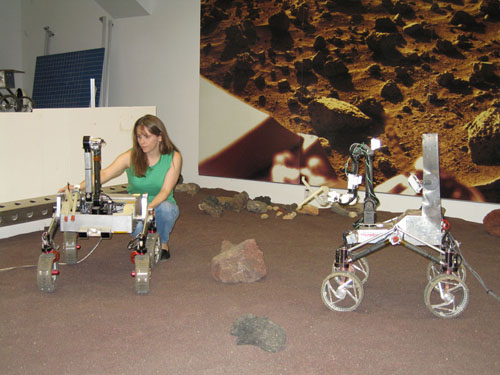
Dr. Ashley Stroupe makes an adjustment to one of a pair of robots that work together, practicing structure building. In the future, robots like the pictured ones could go to Mars to prepare habitats for future human explorers.
Image credit: NASA/JPL-Caltech
http://marsrovers.jpl.nasa.gov/spotlight/20051109.html
LIVE WEBCAST:
“Women Working on Mars: What Do Engineers Do?”
Thursday, February 23, 2006
6:30 a.m. and 11:30 p.m. Eastern Time
http://marsrovers.jpl.nasa.gov/gallery/video/webcast.html
In honor of “Introduce a Girl to Engineering Day”, February 23, 2006, the Mars Public Engagement program and NASA's Robotics Alliance Project are hosting a webcast for young people interested in robotics and engineering.
Do you know what engineers do? Ever wonder about all the different kinds of engineering? Learn more by tuning in to the Women Working on Mars webcast!
Students will see and hear from a diverse group of women engineers from NASA's Jet Propulsion Laboratory. The 40-minute production will highlight an inside look at what they thought about engineering when they were young and what they do now as professional engineers. A live audience and e-mail link will provide many questions for the panelists - you can even email in your own questions and have them answered during the show.
Following the shows, log on to the live web chat and ask your questions directly of women engineers working at NASA!
This program should be of interest to any Vermont students involved in the FIRST robotic competition, working with LEGO Logo or other computer robotics in the classroom or home, or just curious to learn more about robotics and engineering.
20th Anniversary of Challenger Tragedy
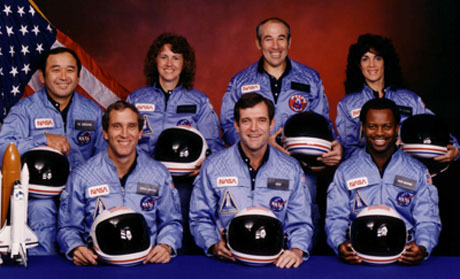
January 28, 2006 is the 20th Anniversary (1986) of the Space Shuttle Challenger tragedy. (Mission 51L) We honor the memory of Commander Dick Scobee, Pilot Mike Smith, Mission Specialists Judy Resnick, Ron McNair, and Ellison Onizuka, Payload Specialist Greg Jarvis, and Space Flight Participant Christa McAuliffe.
While that mission abruptly ended in tragedy, the legacy and education mission of the entire crew lives on. Throughout the United States, and internationally, space education programs are ongoing—reaching out to students, educators and the general public. The dream lives on and space exploration still captures the excitement and imagination of students.
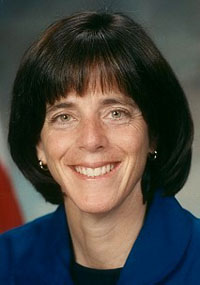
Barbara R. Morgan, was Christa McAuliffe’s “back up space flight teacher participant.” (Both Christa and Barbara were from NASA’s Teacher in Space Program.) After the Challenger tragedy, Barbara Morgan assumed the duties as the Teacher in Space Designee. She is now a fully trained astronaut and official member of NASA’s Astronaut Corps, and the first Educator Astronaut. (Astronaut Class of 1998.) Morgan has numerous assignments and is currently training for her flight to the International Space Station—hopefully during 2006 or 2007.
Here are some related cable/satellite televised programs to remember and honor the crew and their families, as well as to commemorate the anniversary.
VSEP/Gail does not endorse any of these programs listed below as they have not yet been seen or reviewed. The links are provided as suggested resources for educators and the general public.
CNN Presents, hosted by Paula Zahn “Christa McAuliffe Reach for the Stars” airs Sunday, January 22 at 8pm and 11pm ET. Repeats on January 28 and 29 at 8pm and 11pm.
CNN’s Program Overview with Discussion and Activities Suggestions
National Geographic airs “Challenger: The Untold Story” on Monday, January 23, 2006 from 9-11 pm ET. Also airs Tuesday, January 24 12am-midnight, and Saturday, January 28, 8-10pm ET.
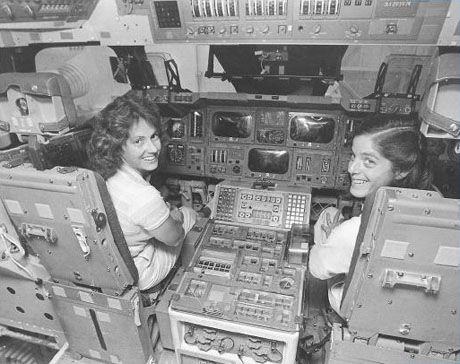
NASA’s Day of Remembrance
“The NASA family pauses on the final Thursday in January for a Day of Rembrance honoring the fallen heroes of Apollo 1, Challenger and Columbia and all of those who have given their lives in the cause of exploration and discovery.” –NASA website, January 26, 2006
Their missions continue as space education continues in Vermont’s classrooms as well as globally. We honor them and their passion for exploration and education so all passengers on planet Earth could benefit from new knowledge obtained during their mission.
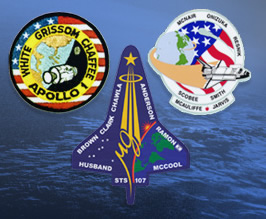
Apollo 1: Edward White, Virgil “Gus” Grissom, Roger B. Chaffee
Challenger: Richard Scobee, Michael Smith, Judith Resnick, Ron McNair, Ellison Onizuka, Gregory Jarvis, Christa McAuliffe
Columbia: Rick Husband, William “Willy” McCool, Michael Anderson, Ilan Ramon, Kalpana Chawla, David Brown, Laurel Salton Clark
Space Patch Quilt
CREDIT UNKNOWN, photo shared by Gail Breslauer. The photo was taken at Framingham State College, January 24, 2006
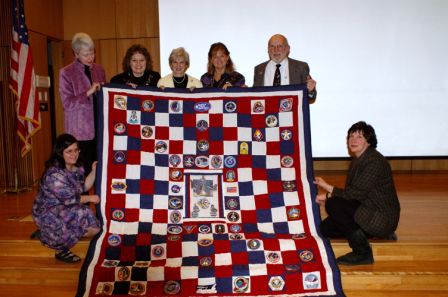
One day, Ms. Still had a moment of inspiration, deciding to create a quilt out of her personal collection of space flown patches. She finished the quilt and decided to donate it to the McAuliffe Center in Framingham, Massachusetts. She presented the quilt to the McAuliffe Center and members of Christa McAuliffe’s Framingham State College graduating class of 1970 who were in attendance for 20th anniversary commemorative events on January 24th, 2006. Members of Christa’s childhood Girl Scout troop and members of her high school graduating class of 1966 were also present, as well as family members and other invited guests. The quilt will be suitably protected and put on display at FSC along with many of the archival mementos on display.
In the photo, from left to right: Kneeling is Leisa Sadwin-Winrich (RI TIS-SA who is still in the classroom teaching learning disabled students), Carolyn Dobbins in lavender (TN TIS-SA, still in the classroom teaching middle schoolers),Sue Darnell-Ellis (KY TIS-SA, a former math teacher now working for NASA in the Education Division), Grace Corrigan, mother of Christa McAuliffe, who continues to visit schools, Teena Still, the quilt maker, who works at JSC as a medical transcriptionist in the Flight Medicine Clinic (and sees all the astronauts and families), Bob Veilleux (NH TIS-SA, former astronomy teacher at Manchester High School, now retired and volunteering at the McAuliffe Planetarium in Concord, NH presenting astronomy programs), and Gail Breslauer (VT-TIS-SA) kneeling on the left.
For more information about the impact and legacy of the Teacher in Space Program, please see the article “The Class of 51-L: Still Touching the Future.”
This article was originally published in the journal Ad Astra, a publication of the National Space Society. The article appears on this website with permission from Ad Astra, as well as the author, Pennsylvania’s Teacher in Space, Patricia Palazzolo.
The article is in Adobe Acrobat format and is approx. 1 meg in size.
This page last updated August 1, 2007.
Vermont Space Education Program
Space Lady Enterprises
PO
Box 550 · Moretown, VT 05660
Phone: 802-496-3795 · Fax: 802-496-3765
gbres@madriver.com
www.VtSpaceEducation.org
All
photos, art & content copyright © 2003, 2004, 2005, 2006, 2007VSEP/SLE
All rights reserved. No photo, drawing, or text may be reproduced in
any form without written consent.
Written
consent is necessary before linking this site to yours!
Please send your requests to: gbres@madriver.com or
VSEP,
PO Box 550, Moretown, VT 05660
